|
The clipper ship Queen of Nations (1861-1881)
|
|
History
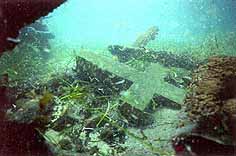
Marble cross near ship's stern - part of the Queen of Nations' cargo.
|
Built in 1861, the wooden clipper ship, Queen of Nations, was one of the highly-regarded vessels of the Aberdeen White Star line. For twenty years, this work of ingenuity and pride transported cargo and passengers between London and Sydney. The ship was admired for its speed and sleek lines.
The next decade saw a major reshuffle in the Aberdeen Line. The older timber ships were sold, scrapped or given a secondary role in the shadow of large iron steamships. Senior captains were slowly transferred to the faster and more efficient new ships. In 1879, Captain Donald, who had commanded the Queen of Nations admirably for almost 10 years, was tragically washed overboard during a heavy storm and lost at sea. It was decided to replace Captain Donald with Captain Samuel Bache, a decision which would prove to be the demise of the Queen of Nations.
|
The Shipwreck
Thousands of bottles of spirits and wine made up part of Queen of Nations' cargo in early 1881. These proved too much of a temptation for Captain Bache. It was reported that both the captain and first mate became "hopelessly drunk" shortly after departing London and remained so for the entire voyage.
In the pre-dawn hours of May 31, 1881, and only a few kilometres south of their final destination, Captain Bache mistook a slag heap fire on Mount Keira off Wollongong for the light on Port Jackson's south head. Believing he was entering Sydney Harbour, he turned the ship toward shore and literally drove through the surf onto Corrimal Beach, just north of Wollongong.
The crew prepared to abandon ship. To their horror, the first mate came crashing onto the deck brandishing a pistol, announcing
that anyone leaving the ship would be shot for desertion. The crew headed to shore anyway and while shots were fired, none found
their mark. Fortunately, the first mate was too drunk to reload. Unfortunately, one person drowned trying to reach shore on a high
tide.
After nearly two weeks of salvage operations, the Queen of Nations began to break up. Cargo, including a great deal of liquor, began washing ashore.
Despite the remoteness of the area, word went out quickly that spoils were to be had and people came from miles around to grab what they could of the booty. Chaos set in and the world's longest and wildest beach party began. Some people didn't leave the beach for weeks and even had meals sent out to them. Newspaper accounts reported that "public drunkenness was common for the next few weeks" and "the result was not at all creditable to the general sobriety which is characteristic of the residents of this neighbourhood".
|
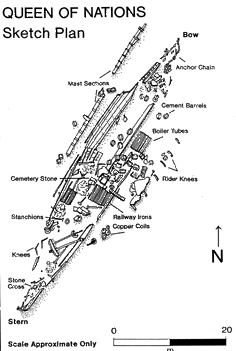 |
|
Location
The Queen of Nations site lies approximately 70 metres off Corrimal Beach opposite the outlet of Towradgi Creek, 4 kilometres north of Wollongong. The remains cover an area of approximately 60x15 metres in a water depth of 3-5 metres, just beyond the surf zone. |
Wreck Site Condition
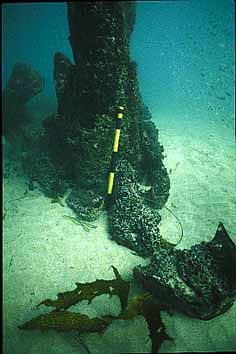
Bow of the Queen of Nations with copper sheathing still visible on stem post.
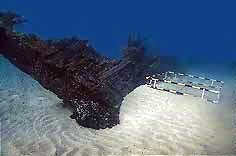
Stern of the Queen of Nations
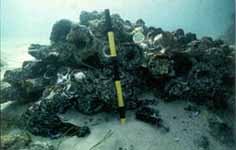
Fire tubes for boilers formed part of the ship's cargo along with rubber
footwear, babies bottles and even cans of lead paint..
|
At least once a decade, violent storms uncover parts of the wreck. In 1976, the wreckage was once again exposed. The proud Queen of Nations was now regarded as nothing more than a swimming hazard. Huge amounts of timber were dragged from the water by bulldozers. Most of this was chopped up and either burned or used as landfill. The lower hull and its contents could not be removed and slowly succumbed to the shifting sands.
Despite human actions and those of the relentless sea, the Queen of Nations still contained a great deal of artefacts and after yet another big storm in 1991, almost the entire remaining structure was exposed. Bottles of spirits and preserved food, railway iron, tins of lead paint, crates of rubber galoshes and even a cemetery headstone were revealed.
By this time, the science of maritime archaeology was well-established and the historical information which could be gleaned from a wreck like the Queen of Nations was well-recognised. The most significant objects on any archaeological site are often the most mundane, but such information is meaningless unless taken in context and conserved and interpreted by trained professionals. The problem with the Queen of Nations was that the site was too accessible and within days, heavy looting had begun.
Commonwealth legislation was already in place to protect historic shipwrecks but declaration was on a ship-by-ship basis. Working
at a feverish pace, NSW Heritage Office Maritime Archaeologists prepared the necessary site surveys and reports. Her protective
status was declared just two weeks later, but sadly, many fragile cargo items which had survived 110 years under the sea had been
stolen, destroyed, washed out to sea or irretrievably damaged. Bottles of Hennesy's Cognac and pickled vegetables deteriorated
quickly once removed from the moist, cool, oxygen free conditions on the wreck site.
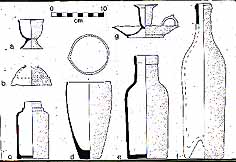
Ceramic and glass ware from the ship's cargo.
The Queen of Nations incident highlighted the need for automatic protection and after heavy lobbying by NSW and other State
officials, a blanket protection was enacted in 1993. Now, any Australian shipwreck older than 75 years is automatically protected and it is illegal to remove artefacts or disturb them in any way. Too late for much of the Queen of Nations, the shipwreck nevertheless has played an important roll in the protection of Australia's maritime heritage.
|
|
The importance of the Queen of Nations
The Queen of Nations is a significant example of an Aberdeen wooden clipper vessel. The wreck contains one of the most easily accessible and substantially sealed archaeological deposits covering this period in New South Wales. The site is also significant in its ability to yield information about various aspects of late nineteenth century trade, in particular, the importation of cemetery stone. In addition, the shipwreck is important for its social and cultural associations with the Wollongong community.
|
|
Listing Information
The Queen of Nations is a gazetted Historic Shipwreck, (7 February 1992), under Section 5 of the Commonwealth Historic
Shipwrecks Act 1976. The listing applies to the shipwreck and all relics associated with the shipwreck. |
|
References
Heritage Office, NSW Shipwreck database, accessible through the
Australian National Shipwreck Database
Nutley, D & Smith, T, 1992, Queen of Nations (1861-1881): Conservation Management Plan, Heritage Branch, Department of Planning, Sydney, NSW, Australia
Saunders, R, 1999, Queen of Nations: A Drunken Tragedy, manuscript prepared for the NSW Heritage Office |
|